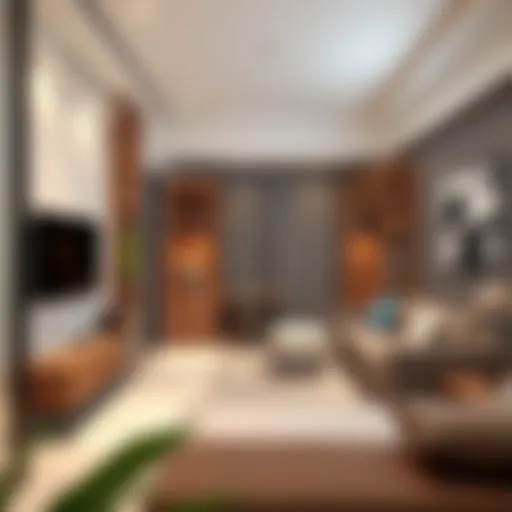Exploring Metrolink: Insights into Union Metro Project


Intro
The Union Metro project stands as a monumental achievement in Dubai's ongoing quest to reshape urban transport and enhance the quality of life within its bustling environment. From its inception to its current operational status, it reflects not just an investment in infrastructure but also a strategic vision aimed at connecting various facets of the metropolitan landscape. By examining its many layers—from design to operation—one can glean insights into how it influences the way residents and travelers navigate this vibrant city.
The Union Metro has not only revolutionized daily commutes but also significantly impacted the surrounding real estate market. As properties near metro stations become increasingly desirable, the connection between public transport and property investment opportunities is clearer than ever. This article aims to explore this relationship, offering potential investors and homebuyers a well-rounded understanding of what it means to live or invest in proximity to the metro.
In the forthcoming sections, we will delve into the current market trends surrounding real estate linked to the Union Metro. We will evaluate how this public transport initiative contributes to overall market dynamics, and we'll provide future projections that could give investors a leg up in an ever-competitive landscape.
Furthermore, we will shed light on property insights by comparing neighborhoods surrounding the Union Metro and detailing various types of properties available. This multifaceted exploration will ultimately provide readers with a comprehensive overview that bridges the essential elements of transportation and real estate, highlighting the unique investment possibilities this development presents.
In essence, understanding the Union Metro's ecosystem is paramount for navigating both today’s and tomorrow’s property markets in Dubai.
Background of Union Metro
The narrative surrounding the Union Metro is significant not only for Dubai's public transport, but also for its broader implications on urban mobility, economic development, and real estate trends. This section will shed light on both the historical context and the development timeline that led to the conception of this essential transit system. Understanding the roots of the Union Metro allows one to grasp its role within a rapidly growing city and its influence on various aspects of daily life for residents and visitors alike.
Historical Context
The journey of the Union Metro began with a vision to modernize the public transport system in Dubai. Prior to its inception, the city witnessed a surge in population and vehicles, leading to unprecedented traffic congestion. In the early 2000s, the Dubai government recognized the need for efficient public transportation as a solution to urban mobility challenges. The plan was laid out in the late 1990s and officially launched in 2005, marking a pivotal moment in addressing the mounting problems associated with transportation.
Key milestones in the construction of the metro included the announcement of feasibility studies, community consultations, and securing the necessary funding. That initial phase demonstrated a commitment from the local government to prioritize sustainable urban growth while responding to the needs of a diversifying population. The completion of the Union Metro heralded a new chapter for a city aiming to cement its identity as a global hub for business and tourism. This context frames not just the metro itself but its implications for social equity, environmental stewardship, and urban planning.
Development Timeline
The timeline of Union Metro's development reflects an ambitious yet structured approach to building an extensive transportation network.
- 1999: Initial studies kick off, diving into the feasibility of a metro system, addressing citizen needs and future growth prospects.
- 2005: Groundbreaking for the project occurs, with construction starting on key segments. This was the year when the Dubai government confirmed their commitment to creating an efficient public transport system.
- 2009: The first phase of the metro line was inaugurated. The Red Line opened for service, connecting major districts from Rashidiya to the UAE Exchange, effectively serving thousands of commuters right from day one.
- 2010: The Green Line was introduced, providing an east-west connection and further integrating various neighborhoods and communities.
- 2017: A historic milestone: the opening of extensions that linked the metro to even more areas, enhancing accessibility and mobility within the city.
- 2020: The comprehensive network boasts over 50 kilometers and numerous stations, facilitating seamless transfers between metro lines, buses, and other forms of transportation.
Throughout each phase, the Union Metro's impact has expanded beyond transportation; it’s influenced real estate dynamics, boosted local businesses, and reshaped urban landscapes. As we delve deeper into the various facets of the Union Metro, one can better appreciate its multifaceted role in redefining the city's fabric.
"The Union Metro isn’t just a means to get from point A to point B; it’s a catalyst for sustainable growth and innovation within Dubai's urban ecosystem."
In this spirit, the investigation of Union Metro continues through various lenses, from its architectural achievements to its socio-economic ripple effects, giving readers a comprehensive insight into its significance.
Sources:
Design and Architecture
The design and architecture of the Union Metro are crucial elements that define its functionality and aesthetic appeal. These aspects go beyond mere visual beauty; they embody the integration of form and function, ensuring that the transit system serves the needs of the city while contributing positively to its skyline.
Structural Innovations
In the realm of structural innovations, Union Metro sets a high bar. The design incorporates state-of-the-art engineering solutions that enhance not just safety, but overall service efficiency. For instance, the use of prefabricated components allows for quicker assembly and improved quality control. This results in lower construction costs and times, helping to get the metro up and running faster to meet growing urban demands.
Additionally, the implementation of advanced train control technologies minimizes the risk of accidents and ensures timeliness, which is absolutely essential for a bustling metropolis like Dubai. Modern tunnels, often underground, utilize cutting-edge drainage systems that prevent water accumulation, safeguarding the structural integrity and longevity of the lines.
Another noteworthy innovation is the incorporation of modular design principles. This allows for future expansions or modifications, keeping pace with the evolving needs of urban connectivity.
Sustainable Features
Sustainability has become a buzzword in modern construction, and the Union Metro does not disappoint. Incorporating eco-friendly materials is at the forefront of its design ethos. Not only does this choice reduce the carbon footprint during the construction phase, but it also takes a step further by using renewable resources, which can appeal to environmentally-conscious investors and homebuyers alike.
The metro stations are equipped with efficient energy systems, including solar panels on rooftops. This enables them to harness natural energy, contributing to reduced operational costs and energy consumption. Plus, the design promotes natural lighting which lessens reliance on artificial light during the day, creating a more pleasant environment for commuters.
Another key feature is how the design integrates greenery into its aesthetic, with vertical gardens at some stations. This not only beautifies the transit space but also improves air quality, a consideration that’s increasingly important in urban environments.
"The design philosophy of the Union Metro serves as a model for future urban transit systems, marrying functionality with sustainable practices."
Operational Aspects
Understanding the operational aspects of Union Metro is fundamental to appreciating its broader role in enhancing urban mobility within Dubai. These operational characteristics not only dictate the day-to-day functioning of the metro system but also reflect the commitment to modernity and efficiency in public transportation. The integration of advanced technologies shapes rider experiences while addressing the critical needs of an ever-growing city.


Technology Integration
At the heart of Union Metro's functionality is its robust technological framework. By leveraging cutting-edge systems such as Automatic Train Operation (ATO) and real-time tracking, the metro ensures that trains run on time. This level of precision is crucial, as delays could have a domino effect on commuters, businesses, and even emergency services.
The use of mobile applications further enhances the integration of technology. Passengers can access schedules, purchase tickets, and receive alerts about service changes with ease.
"The seamless functionality of Union Metro is a testament to the effective use of modern technology. It makes daily commuting feel effortless," explains a transport analyst.
Moreover, the system employs smart card technology like the NOL card, which allows for cashless travel and streamlines the boarding process. Such efficiencies not only save time but also contribute to a more organized transit environment.
User Experience
User experience in Union Metro is carefully crafted to cater to the diverse population of Dubai. From tourists to daily commuters, the metro prides itself on inclusiveness and accessibility. Stations are designed with wide entrances and facilities that accommodate individuals with disabilities, proving that user-centric design lies at its foundation.
Noise and comfort have not been overlooked either. The design of train cars and station layouts minimizes loud disturbances while maintaining a spacious feel. Many stations also incorporate artworks and cultural displays, providing a visually engaging journey for passengers as they move from one destination to another.
Besides physical comfort, the Union Metro offers significant psychological benefits. For instance, knowing that you can rely on a punctual transport system alleviates stress, making the urban experience more enjoyable. Riders can use travel time productively, whether that’s catching up on work via Wi-Fi available in some areas or simply enjoying their commute.
Furthermore, the metro is not just about getting from point A to point B; it’s about the journey itself. With the integration of information panels displaying upcoming train schedules and points of interest at each station, riders feel informed and engaged.
In sum, the operational aspects of Union Metro hinge on a strategic blend of technology and user-focused design. This understanding serves as a critical element for stakeholders, including investors and city planners, who are interested in the long-term benefits of the metro system.
Impact on Urban Mobility
The introduction of the Union Metro has acted as a catalyst for change in urban mobility across Dubai. Its role goes far beyond simply shuttling passengers from one point to another; it has reshaped how people navigate their daily lives and access opportunities within the city. In a metropolis like Dubai, known for its rapid growth and congestion, the effectiveness of a public transportation system can significantly influence overall mobility patterns. The Union Metro stands out as a model for enhancing urban transit efficiency and accessibility.
Reduction of Traffic Congestion
One of the foremost benefits of the Union Metro is its capacity to alleviate traffic congestion. With more people opting to use the metro, fewer cars crowd the already busy streets. This train system offers a reliable alternative for commuting that reduces dependency on personal vehicles. A clear illustration of this can be seen during peak hours. The metro lines carry thousands of passengers, which would otherwise contribute to long traffic jams on the roads.
The remarkable thing about this shift is the ripple effect it creates. With fewer cars on the road, there are not only quicker journeys for those who choose to drive, but a decrease in exhaust emissions, promoting cleaner air quality. According to studies from the Dubai Roads and Transport Authority, investing in rail systems like the Union Metro can lead to a 30% reduction in traffic congestion within the vicinity of metro stations.
- Improved travel times
- Reduced wear and tear on road infrastructure
- Encouragement of public transport usage as a sustainable choice
Ultimately, the metro has the potential to transform the way Dubaians approach their daily commutes, ensuring that time spent in transit is both less burdensome and more efficient.
Enhancing Accessibility
Accessibility is a critical feature of any successful public transport infrastructure, and the Union Metro excels in this area. It connects various neighborhoods and key locations, making it easier for residents and visitors to reach their destinations without the barriers often faced by those relying on personal vehicles. This increase in accessibility is particularly important for diverse communities living in the surrounding areas, providing them with direct access to employment, education, and recreational facilities.
The design of the Union Metro stations showcases a commitment to user-friendly features. With wheelchair ramps, elevators, and clear signage, the system accommodates individuals with varying degrees of mobility. This inclusivity ensures that no one is left behind, allowing everyone to benefit from the expanded transport network. In addition, the integration of technology, such as mobile apps for real-time updates, enhances user experience, particularly for first-time riders.
In the context of increasing urban density, the role of the Union Metro in enhancing accessibility becomes even more significant. It helps link people with opportunities across the city, reinforcing the idea that efficient transport is a cornerstone of thriving urban life. Moreover, neighborhoods that were previously under-served have seen revitalization, fueled by the connection to the metro lines.
"Improved access to metro services can significantly enhance the quality of life for residents, providing them with a greater sense of mobility and autonomy."
In summary, the Union Metro not only addresses pressing issues of traffic congestion but also plays a pivotal role in enhancing accessibility in Dubai. This multifaceted approach to urban mobility allows for a holistic improvement in how residents navigate their city, setting a precedent for future transport initiatives.
Economic Implications
Understanding the economic implications of the Union Metro is crucial for grasping the broader impact this transportation system has on Dubai's landscape. This project is not merely a mechanism for transit; it's a catalyst for economic growth and development. The metro does not exist in isolation; rather, it intertwines with local markets, real estate trends, and business dynamics. The way it influences these sectors will resonate through time, shaping the city’s economic fabric for years ahead.
Stimulating Local Businesses
The presence of the Union Metro has the potential to stimulate local businesses in profound ways. By providing a reliable and efficient means of transportation, the metro opens up avenues for foot traffic that businesses can capitalize on. Consider a small café planted near a metro station: the daily commuters and visitors who hop off at that stop become an instant customer base. They might stop in for coffee on their way to work, grab lunch, or even browse after a long day.
The metro can also enhance visibility for retail shops situated along its routes. When people can easily access these businesses, sales often see an uptick, allowing them to thrive. Furthermore, with improved connectivity, local entrepreneurs can attract consumers from farther afield, expanding their market reach beyond traditional boundaries.
- Boost to Retail: Shops situated near metro stops experience increased customer engagement driven by the convenience of public transport.
- Diverse Options: Restaurants and cafés can offer various cuisines and experiences that appeal to a wider audience, benefiting from the enhanced accessibility.
- Job Creation: As businesses grow, so does the need for employees. This creates sustainable jobs and employment opportunities within the community.
Like a spider weaving its web, the metro creates connections within the local economy, linking businesses, workers, and customers in new and exciting ways.
Influencing Real Estate Prices


The economic ramifications of the Union Metro are particularly keenly felt in the realm of real estate. As the metro expands, areas in close proximity to stations often see a surge in property values. For investors and homebuyers, understanding this dynamics is essential when contemplating purchases or sales. The presence of a metro stop typically transforms a neighborhood, shifting its desirability and pricing structure almost overnight.
Real estate analysts have noted that properties near transport hubs tend to appreciate faster than those in more isolated areas. Buyers seeking easy commutes are often willing to pay a premium for homes or apartments a stone's throw from a station. Conversely, properties farther away may struggle to keep pace with this growth, leading to pronounced differences in price.
- Price Appreciation: Homes near metro lines often see a steady rise in values, making them attractive investment opportunities.
- Rental Demand: As commuting costs grow, many renters seek proximity to metro stations, which increases demand and, consequently, rental prices.
- Future Growth: Areas linked to the metro are likely to see additional amenities and infrastructure improvements, further enhancing their appeal.
In summation, the Union Metro stands as a cornerstone of economic vitality. It fosters local businesses and significantly influences real estate markets by intertwining urban life with accessible transport solutions.
"Investment in metro systems ultimately transforms urban areas into vibrant economic hubs, driving growth and enhancing the quality of life for residents."
For further information on metro systems and their impact on real estate, explore resources like Wikipedia and Britannica.
Neighborhood Impact
The Union Metro is not just a rail system; it's a pivotal element reshaping the very fabric of neighborhoods it touches. As commuters zip off to their destinations, the surrounding communities feel the ripples of accessibility and economic opportunity. The importance of understanding the implications of this transformation cannot be overstated. Real estate values fluctuate, local businesses thrive, and long-standing social dynamics undergo a renaissance. All these facets make the Union Metro a powerhouse for neighborhood revitalization and, ultimately, a case study for urban development.
Areas Benefiting from Union Metro
Several neighborhoods are on the receiving end of the Union Metro's promise. The lines carved through the city have sparked growth in areas once considered off the beaten path. For instance:
- Deira: Known for its bustling souks, the introduction of metro access has catalyzed a surge in tourism and retail. Visitors can explore the rich tapestry of its market culture more easily.
- Jumeirah: The affluent district is not only gaining accessibility for locals. High-profile hotels and restaurants have begun investing in spaces close to the metro stations.
- Al Quoz: A hub for art and commerce, the metro has bolstered foot traffic, prompting galleries and startups to bloom in what used to be mainly an industrial area.
- Dubai Marina: With its scenic waterfront, the metro has made it less of a challenge for residents to travel into the city center or to the beach, thereby elevating the neighborhood's appeal.
These and other communities are seeing new businesses enter the fray. The convenience of transportation is enticing entrepreneurs and drawing in visitors, making the metro lines a magnet for economic activity.
Real Estate Trends in Surrounding Neighborhoods
The impact of the Union Metro goes beyond immediate economic growth; it has profound implications on real estate trends in the neighborhoods nearby. Many potential buyers and investors now see proximity to metro stations as a vital selling point. Some key trends include:
- Rising Property Values: Areas near metro stations are experiencing noticeable increases in property prices. For example, homes once valued modestly are fetching premium prices due to their new accessibility.
- Increased Rental Demand: There’s a marked uptick in rental inquiries from both expatriates and locals seeking easy access to public transport. This demand is driving up rental rates, making properties in metro-adjacent neighborhoods highly sought-after.
- Gentrification: Some neighborhoods, previously characterized by older homes and lower-income residents, are undergoing gentrification. Investors looking to capitalize on the transit system are renovating properties, leading to an influx of higher-income residents and modern amenities.
- Shift in Preferences: A new trend is emerging where more individuals are favoring shorter commutes over larger living spaces. Living near a metro station allows for a balanced lifestyle, combining convenience with urban living.
As urban planners, real estate analysts, and prospective homebuyers scrutinize these trends, it becomes clear that the Union Metro is more than just a transportation initiative; it’s a transformative agent for neighborhoods, unlocking possibilities and reshaping future urban landscapes.
The synergy between public transport and community development is vital; without it, the benefits of modern urban living may just remain a dream.
Future Expansions
The concept of future expansions within the Union Metro project is crucial not only for its operational success but also for its role in shaping urban growth. With the increasing population of Dubai, there is an unmistakable demand for more efficient public transport options. This subsection will delve into the upcoming plans and developments, detailing how they align with the vision of a connected and accessible city.
Upcoming Line Extensions
One of the most buzzworthy elements surrounding the Union Metro is the plan for upcoming line extensions. These proposed additions aim to interlink various neighborhoods, fostering greater accessibility.
- Increased Coverage: The extensions are thoughtfully designed to cover underserved areas, allowing residents to travel to key destinations without the dependency on personal vehicles. Expansion helps in alleviating road congestion, contributing to a smoother traffic experience in Dubai.
- Connections to Key Locations: Notable plans may include links to the Expo 2020 infrastructure, airport terminals, and major shopping districts. Each new extension serves as a linchpin, helping to weave the city into a robust network that nurtures both short-term commutes and longer journeys.
- Investment Opportunities: For those observing the market, such expansions translate to potential investment prospects. As new stations emerge, surrounding properties are likely to experience preferential price escalations. Investors should remain alert to these development patterns.
"The Union Metro line extensions not only improve connectivity but also catalyze economic activity and urban revitalization."
Future Developments in Transit-Oriented Areas
The unfolding of transit-oriented developments is set to transform the urban landscape surrounding the metro lines. Instead of merely adding new tracks and stations, this strategy emphasizes multi-use developments encircling transit hubs.
- Mixed-Use Developments: The focus will be on creating vibrant spaces where people can live, work, and play. Properties ranging from high-rise apartments to commercial facilities are designed to be within a stone's throw from metro stations. This urban design enhances the livability of the area, promoting a lifestyle less reliant on vehicles.
- Sustainable Practices: Future developments are likely to prioritize sustainability. Construction can incorporate eco-friendly materials, energy-efficient technologies, and green spaces. This aligns well with the global commitment to reduce carbon footprints, making these projects more appealing to eco-conscious investors.
- Smart City Initiatives: Consideration is also given to smart city elements. Integration of technology for services and amenities surrounding metro stations not only elevates user experience but also promotes a sense of community. This could lead to enhanced safety, quicker transit times, and improved overall quality of life.
Investors, homebuyers, and anyone interested in real estate trends should keep their eyes peeled for developments around Union Metro's future expansions. The potential for enhanced connectivity and growth opportunities is high, making this an area ripe for exploration.
Comparative Analysis
In any discussion surrounding urban transit systems, a comparative analysis serves as a pivotal tool. It allows stakeholders to evaluate the strengths and weaknesses of various transport modalities, which is especially crucial for a project like Union Metro. Such analysis not only enhances understanding but also informs decision-making for investors and residents alike.
When weighing the Union Metro against its contemporaries, a few essential elements emerge. First and foremost, understanding operational efficiency and connectivity is key. What sets Union Metro apart from other transport systems is its integration with existing modes of transport, making it a cornerstone of Dubai's public transportation framework. The reliability and frequency of services bring convenience to commuters, ensuring that they aren't left high and dry during peak hours.
Moreover, exploring different pricing models in relation to service quality can highlight potential areas of improvement. The Union Metro offers competitive fares that cater to both budget-conscious riders and those looking for premium services. Such diversity encourages greater ridership.
Union Metro vs. Other Transport Systems


A comparison between Union Metro and other metro systems around the world paints a vivid picture of choices available to cities. Take, for instance, the New York City Subway which runs 24/7 but is riddled with delays and aging infrastructure. In contrast, Union Metro is a more modern system with cutting-edge technology, doubling down on efficient service and robust safety protocols. Its sleek design and functionality mirror systems like the Tokyo Metro, but with unique adaptations that cater specifically to the cultural and demographic conditions present in Dubai.
The Union Metro sets a standard for others by being one of the few systems that provide high-quality services with a relentless focus on the user experience and sustainability.
Additionally, one cannot ignore the role of integration within the urban fabric. While cities like London integrate their underground with bus networks effectively, Union Metro is rapidly evolving to link seamlessly with Dubai's burgeoning ride-sharing services. This proactive approach demonstrates a responsiveness to market trends and a commitment to cater to the modern commuter.
Lessons from International Metros
A look to international metros provides invaluable lessons for the Union Metro's ongoing evolution. Cities that successfully managed to blend public transport networks with urban development can offer a roadmap for future expansions. For instance, Copenhagen's metro system has inspired planners worldwide with its innovative tunnels and integration of green spaces. This focus on sustainability and design should ring true for Union Metro, emphasizing the idea of a metro system that not only transports people but enhances the urban environment.
Further, cities that employ adaptive pricing strategies can increase efficiency while also ensuring accessibility. The concept of dynamic pricing, as seen in cities like Singapore, is an area that could serve as a model for enhancing the Union Metro's revenue without alienating low-income users. By striking a balance between affordability and sustainability, cities can create a more equitable transit system.
As the Union Metro continues to develop and adapt, keeping an eye on these lessons can foster a transport system that not only meets but exceeds the expectations of its users and stakeholders. By learning from both its local environment and international counterparts, the Union Metro stands poised to redefine urban mobility in Dubai.
Epilogue
The conclusion of this article serves as a pivotal moment, wrapping up the myriad discussions around the Union Metro project and its multifaceted impacts. It is not merely an endpoint; instead, it underscores the importance of integrating public transport into urban planning, which can significantly enhance city living and investment opportunities.
Summation of Key Insights
Throughout this article, we dived deep into the various aspects of the Union Metro, revealing its historical context, architectural breakthroughs, and operational features. One striking insight highlights that the metro does more than just connect points in Dubai; it actively shapes the socio-economic landscape.
- Historical Context: The Roots of Union Metro stretch back to the city’s ambitious vision for sustainable urban mobility.
- Design Innovations: The metro’s architecture, a blend of modern aesthetics and functionality, reflects a commitment to sustainability and user friendliness.
- Economic Impact: Businesses flourish in its vicinity, showcasing the symbiotic relationship between real estate markets and efficient transportation systems.
- Future Growth: Plans for future expansions mean the Union Metro is set to resonate even more profoundly across Dubai's neighborhoods.
These components paint a comprehensive picture of how the Union Metro isn’t just a mode of transit, but a keystone in the urban development of Dubai.
Final Thoughts on Future Prospects
Looking ahead, the Union Metro stands at a crossroads of immense potential. Urban planners and investors alike should keep a close eye on developments in this sphere. The introduction of new lines and extensions will likely reshape current dynamics, bringing yet unforeseen advantages.
As Dubai continues to grow, the Union Metro’s role is bound to evolve, offering an unmatched opportunity for property investors and buyers who recognize the value of proximity to this mode of transport.
As stated, "The metro is the pulse of urban mobility, and understanding its rhythm is key to unlocking future opportunities in real estate and urban development."
The future of this transportation network will not only influence the daily lives of commuters but also propel the city towards a smarter, more connected future. This aspect is crucial for investors, ensuring that they are attuned to market movements driven by transit developments.
In summary, while the Union Metro currently serves as a critical artery for Dubai, its true impact may only be understood in the broader context of urban innovation and economic viability. Being proactive in this space is wise, as the interplay of transportation and real estate continues to reveal lucrative avenues for strategic investment.
Expert Opinions
Understanding the perspectives of experts can significantly enhance our grasp of the complexities surrounding the Union Metro project. Delving into expert opinions not only enriches the narrative but also provides a multifaceted view of the metro's impacts on urban planning and real estate dynamics. By gathering insights from key stakeholders, we can uncover valuable viewpoints that inform potential investors and residents looking to navigate the evolving landscape of Dubai's public transportation.
When experts speak, they lend credibility to the discourse on urban mobility. Their analyses are informed by years of experience and research, offering ideas that go beyond surface-level observations. Therefore, engaging with experts comes with several benefits:
- Informed Insights: Professionals in urban planning and real estate can illuminate trends that may not be readily visible to the average observer.
- Future Predictions: Analysts with experience in market forecasting can provide predictions on property value changes in proximity to transit routes, which can guide investment decisions.
- Holistic Viewpoints: Different experts, from urban planners to real estate analysts, provide perspectives that can create a well-rounded understanding of the metro's various effects.
The following sections will detail interviews conducted with urban planners and insights gained from real estate analysts, allowing readers to gain a well-founded understanding of the multifarious impacts of the Union Metro.
Interviews with Urban Planners
Urban planners play a pivotal role in shaping the future of cities alongside projects like the Union Metro. Their hands-on experience in the design, implementation, and regulation of transportation systems makes their insights invaluable. In interviews with several prominent urban planners in Dubai, several themes emerged, notably its role in promoting walkability and accessibility.
According to one planner, "The Union Metro not only serves as a cornerstone for public transport but also encourages residents to think about sustainable living options. We aim to make neighborhoods more interconnected, reducing reliance on cars."
Additionally, planners discussed how metro stations are designed to serve as hubs of community activity. Essential components of these discussions included:
- Integration with Existing Infrastructure: How the metro fits into the already developed urban fabric and enhances the quality of life.
- Adaptive Reuse of Land: Opportunities to repurpose land around stations for parks, commercial spaces, or residential units that attract diverse populations.
- Public Engagement: The importance of involving community feedback in planning processes to ensure that the metro meets the needs of residents.
These insights underscore that while the metro is simply a transport system, it profoundly influences the broader urban fabric of Dubai.
Insights from Real Estate Analysts
Real estate analysts are another crucial segment of the expert landscape. Their analyses often guide investors through potential opportunities presented by proximity to transportation hubs like the Union Metro. Insights gathered from real estate analysts reveal a striking correlation between the metro's operational status and burgeoning property values in nearby areas.
One analyst noted, "Investors should view Union Metro as a catalyst. Properties that once seemed peripheral are now central to a growing urban narrative that attracts buyers across demographics."
Key points from analysts include:
- Increased Demand for Housing: As ease of transport grows, so does the attractiveness of nearby real estate. Properties within walking distance of metro stations enjoy a boost in demand and consequently in price.
- Long-Term Growth Projection: Analysts expect neighborhoods adjacent to Union Metro to see sustained growth, as they are primed for development and urban renewal.
- Market Adjustments: A dynamic transportation network can influence real estate market patterns, necessitating ongoing monitoring of trends as the metro expands.
By dissecting the expert opinions of urban planners and real estate analysts, one can appreciate that the Union Metro represents much more than just a transport service; it is a transformative force in Dubai’s urban landscape.















